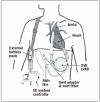Left ventricular assist device: a functional comparison with heart transplantation
- PMID: 18335020
- PMCID: PMC2245815
- DOI: 10.1007/BF03086116
Left ventricular assist device: a functional comparison with heart transplantation
Abstract
Background: A growing number of patients with end-stage heart failure undergo implantation of ventricular assist devices as a bridge to heart transplantation.
Objectives: In this study we investigated whether functional and haemodynamic recovery after implantation is sufficient to warrant the use of them as long-term alternative to heart transplantation.
Methods: We compared peak VO(2) of a group of patients three months after implantation of a ventricular assist device and three months after heart transplantation. Furthermore, we analysed the degree of haemodynamic recovery, by comparing plasma levels of BNP and creatinine before and after implantation of the device.
Results: After implantation of a ventricular assist device, exercise capacity improved considerably; three months after implantation peak VO(2) was 20.0+/-4.9 ml/kg/min (52% of predicted for age and gender). After heart transplantation exercise capacity improved even further; 24.0+/-3.9 ml/ kg/min (62% of predicted for age and gender) (p<0.001). In the three months after implantation, BNP plasma levels decreased from 570+/-307 pmol/l to 31+/-25 pmol/l and creatinine levels decreased from 191+/-82 mumol/l to 82+/-25 mumol/l, indicating significant unloading of the ventricles and haemodynamic recovery.
Conclusion: With regard to functional and haemodynamic recovery, the effect of implantation of a ventricular assist device is sufficient to justify its use as an alternative to heart transplantation. (Neth Heart J 2008;16:41-6.).
Keywords: heart failure; heart transplantation; ventricular assist device.
Figures



References
-
- Packer M, Coats AJ, Fowler MB, Katus HA, Krum H, Mohacsi P, et al. Effect of carvedilol on survival in severe chronic heart failure. N Engl J Med 2001;344:1651-8. - PubMed
-
- Jaski BE, Lingle RJ, Kim J, Branch KR, Goldsmith R, Johnson MR, et al. Comparison of functional capacity in patients with endstage heart failure following implantation of a left ventricular assist device versus heart transplantation: results of the experience with left ventricular assist device with exercise trial. J Heart Lung Transplant 1999;18:1031-40. - PubMed
-
- Chatterjee K. Refractory heart failure - drugs and devices. Eur Heart J 2001;22:2227-30. - PubMed
LinkOut - more resources
Full Text Sources
